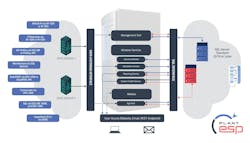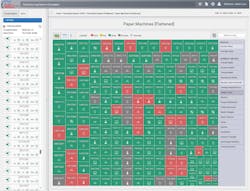Enterprise-scale analytics propel paper & packaging production improvements
Process plant optimization is often considered to be a bottom-up affair, where individual control loops are tuned one-by-one to improve overall operating efficiency. While this approach certainly delivers incremental progress, there is a case to be made for expanding the perspective to achieve greater and more widespread gains at a much faster pace by following a top-down approach. This type of tactic enables large numbers of similar loops, operating assets and even production facilities to be compared so the best examples are identified, with positive outcomes then deployed throughout the organization.
As a leading global manufacturer of paper and packaging products, Smurfit Westrock operates numerous production facilities employing over 100,000 staff across 40 countries, with over $32 billion in annual revenue. Recognizing the importance of improving autonomous operation throughout all production units, the Process Control and Optimization group within the organization undertook an initiative within the pulp mills to incorporate process analytics in support of optimization (Figure 1).
The team was already familiar with the value of control loop performance monitoring (CLPM) software, and it had implemented various solutions at some production facilities. However, to maximize the effectiveness of CLPM, they saw the need to deploy a singular solution throughout the enterprise, with the right provisions to standardize and facilitate organization-wide optimization. The solution had to fit architecturally with existing company assets, be easy-to-use by mill staff and centralized IT and controls teams, and offer excellent supplier support and domain expertise to accelerate implementation and results.
Embarking on data-driven optimization
Modern businesses recognize the need to obtain and use data for supporting better decision-making. For optimizing operational technology (OT) assets, tapping into the multitude of data sources requires digitalization, which can be a big endeavor for many companies. Fortunately, WestRock already has extensive digital process controls and historians in place as a solid foundation.
Furthermore, the team was very familiar with building software solutions for monitoring certain performance and financial aspects of the business, but these efforts were primarily information technology (IT)-based. The new solution would need to have an OT focus, and it was important that both control engineers and business management would benefit. The group initially allocated two months for in-house development of a home-grown software solution, but it was clear that this was a high-overhead option which would almost certainly not be viable over the long term.
Meeting key requirements
As a next step in the investigation, the team evaluated five potential solution providers, with each of them asked to work with a subset of source data as part of a head-to-head trial. There were many requirements set forth for this evaluation, including these significant needs:
- A connectivity architecture able to integrate seamlessly with the existing historians.
- An easy-to-use and intuitive interface for all levels of users so they could access and take advantage of key performance indicators (KPIs) and advanced forensic analysis tools by integrating them with broader data analytics and business intelligence (BI) initiatives.
- Supported by a CLPM supplier with a demonstrated record of excellence in customer support and a shared vision of success.
Through the evaluation process, one company stood apart from the competition by meeting and exceeding these and other requirements. Control Station, with their PlantESP CLMP offering and the availability of support services, became the clear choice.
Smurfit Westrock sought seamless integration with its existing AVEVA PI System data historian deployed at each site. Since 2017, Control Station has been partnered with AVEVA — and with its predecessor OSIsoft — and Control Station was the first CLPM vendor to support integration using the PI-SDK. This eliminated the security issues associated with OPC-DA and other data interfaces, and it standardized the structure by which data calls were configured.
In 2019, Control Station’s PlantESP solution added a template for browsing the PI System’s Asset Framework, further simplifying integration. From an architectural standpoint, this approach supports the many ways that manufacturers like Smurfit Westrock organize process data by using common categories and subgroups. Furthermore, PlantESP was the first CLPM solution to include a representational state transfer (REST) application programming interface (API), so data and results could be integrated throughout the enterprise (Figure 2).
PlantESP provides automatic PID modeling and integrated state-based functionality for rapid and effective implementation. The software incorporates standard KPIs needed for most process industries, and it includes advanced forensic tools, such as power spectrum and cross correlation analysis. Together, these features make it easy for users of all levels to deploy, monitor, investigate and then act to optimize operations.
As Smurfit Westrock discovered through interviews with other PlantESP users — and then experienced through the actual deployment and usage — Control Station had developed extensive domain expertise, demonstrated solid plans for product innovation and was committed to significant customer engagement and collaboration. Because Smurfit Westrock proposed an aggressive project plan, expectations for responsiveness from the selected vendor were high and essential to achieve project success.
Implementation
From the outset, the Smurfit Westrock team knew that they did not want to create and maintain additional interposing databases. They were aware that some CLPM solutions require their own specialized databases, infrastructure and/or logic, which demands considerable effort, along with upfront and ongoing support costs. Connecting right to the PI data source — which is the PlantESP approach — is the best way to obtain high-quality data which is conditioned and scrubbed/cleaned. Because PlantESP works natively with and takes advantage of the PI Asset Framework, all data and conditioning information flow through seamlessly from PI to PlantESP.
The only issue concerning the team was that their historians had been populated and grown organically over time, leading to some degree of inconsistency. Therefore, part of this project was to audit the PI implementation against the underlying control systems, and to then standardize usage for interfaces, tags, parameters, control loops, PIDs, motor control and more. An execution plan enabled Smurfit Westrock to engage several PI-specific systems integrators (SIs) to perform this work in parallel at different sites, speeding implementation for obtaining reliable and trustworthy data. The work initially started at one site, and once it was 70% complete the project ramped up and expanded to address two and then three sites at a time. After the PI infrastructure was updated at each site, PlantESP was deployed at the site and the local team was trained by Control Station.
About 25,000 control loops throughout 24 facilities were evaluated in the brief span of 14 months following this approach. Within 6 months of project launch, Smurfit Westrock was documenting performance improvements in the tens of millions of dollars (Figure 3).
PlantESP output is looped back into PI, allowing existing Power BI corporate reports on KPI-based performance to include and compare all production sites. The company now uses this framework for reviewing results formally on a monthly and quarterly basis, and informally on a weekly cadence or as needed, to assess PlantESP findings and implement improvements.
The complete package
Every company seeks improved efficiency, and those using CLPM software certainly look to relate better loop performance with financial metrics. The Control Station solution implemented at Smurfit Westrock sites provides the necessary tools to do so. For a large mill, the efficiency gains using this solution are very high, and company-wide several million dollars of positive impact has been identified. Certainly, double-digit percentage point improvements on energy consumption, chemical usage, quality and loss reduction have been recognized — and Smurfit Westrock believes there is still significant upside to come from this solution.
There are other ancillary benefits as well. Many companies like Smurfit Westrock find it is easier to recruit top-tier controls engineer talent at a centralized corporate location, as opposed to many different sites. This software solution supports that model, and it enables effective collaboration throughout the company (Figure 4).
Control Station provides ongoing semi-annual training to ensure Smurfit Westrock is obtaining full value from their CLPM investments. WestRock has found Control Station to be agile and ready to listen and respond to requirements and requested software modifications, in addition to providing the best price/performance ratio in the market.
Although Control Station may not have been the only prospective supplier that initially called out the project timeline as being overly ambitious, the company agreed to try based on positive past experiences. A partnership and collaborative mindset enabled rapid deployment of a high-performance solution spanning 24 facilities in just 14 months, which was significantly faster than the contracted 18-month timeframe. Control Station truly understood what WestRock was trying to do and worked with them to reach their shared goals, and success followed.
About the Author

Eric Gilbert
Director of Process Control at Smurfit Westrock
Eric Gilbert is Director of Process Control at Smurfit Westrock where he leads the process control analytics and optimization effort across production facilities located throughout the Americas. Mr. Gilbert began his career as an instrumentation, controls and electrical engineer in 2013. He joined WestRock—now Smurfit Westrock—in 2016 as a divisional electrical and controls manager. Mr. Gilbert was recognized by the Technical Association of the Pulp and Paper Industry as the 2024 Professional of the Year for his work in plantwide process optimization.

Robert Rice
Vice president of engineering at Control Station
Robert Rice, PhD is the vice president of engineering at Control Station. He is Control Station’s thought leader, and he has published extensively on topics associated with automatic process control, including multi-variable process control and model predictive control. Dr. Rice has been the recipient of numerous awards for innovation, and for his contributions to the advancement of the process industry. He received his BS in Chemical Engineering from Virginia Polytechnic Institute and State University, and his MS and PhD from the University of Connecticut.



